## 一.转换函数的类型
1. 转换构造函数:从其他类型到类类型 `T`
2. 类型转换函数:从类类型 `T` 到其他类型
## 二.转换构造函数
### 1.工作
它的主要工作是构造对象,顺带完成类型转换工作。
### 2.调用方式
**既可以被编译器自动调用,也可以被用户强制调用。**
### 3.定义和声明
+ 转换构造函数是构造函数中的一种,其定义和声明与构造函数是一样的。
+ 转换构造函数在调用时只会传入一个参数,因此应该保证 **转换构造函数至少有一个形参,且最多只有一个形参没有默认参数** 。
#### 例1
下面是一个带有转换构造函数的类 `Complex` 。
```c++
class Complex
{
private:
double real_;
double imaginary_;
public:
Complex() : real_(0), imaginary_(0)
{
}
//转换构造函数
Complex(double real) : real_(real), imaginary_(0)
{
}
Complex(double real, double imaginary) : real_(real), imaginary_(imaginary)
{
}
Complex &set_real(double new_val)
{
this->real_ = new_val;
return *this;
}
Complex &set_imaginary(double new_val)
{
this->imaginary_ = new_val;
return *this;
}
};
```
然后,就可以这么创建对象:
```c
Complex a,b = 6,c(6,5);
```
接下来,我们来简化构造函数:
```c++
class Complex
{
private:
double real_;
double imaginary_;
public:
Complex() : real_(0), imaginary_(0)
{
}
//既是转换构造函数,也是普通构造函数
Complex(double real, double imaginary = 0) : real_(real), imaginary_(imaginary)
{
}
Complex &set_real(double new_val)
{
this->real_ = new_val;
return *this;
}
Complex &set_imaginary(double new_val)
{
this->imaginary_ = new_val;
return *this;
}
};
```
然后依然可以这么调用:
```c
Complex a,b = 6,c(6,5);
```
最后我们进一步简化构造函数:
```c
class Complex
{
private:
double real_;
double imaginary_;
public:
//缺省构造函数,转换构造函数,普通构造函数
Complex(double real = 0, double imaginary = 0) : real_(real), imaginary_(imaginary)
{
}
Complex &set_real(double new_val)
{
this->real_ = new_val;
return *this;
}
Complex &set_imaginary(double new_val)
{
this->imaginary_ = new_val;
return *this;
}
};
```
照样可以这样调用:
```c
Complex a,b = 6,c(6,5);
```
## 三.类型转换函数
### 1.调用方式
**既可以被编译器自动调用,也可以被用户强制调用。**
### 2.定义和声明
+ 类似于重载强制类型转换运算符。
+ 只能 **在类内重载** 。因为转换的主体是对象本身。
+ 没有参数。因为调用时第一个参数为对象本身。
>[warning] 由于类型转换函数只能被编译器自动调用,它不允许添加默认参数。
+ 不可指定返回类型。但它有返回类型。
#### 例2
下面是一个带有类型转换函数的类 `Complex` 。
```c++
class Complex
{
private:
double real_;
double imaginary_;
public:
Complex() : real_(0), imaginary_(0) {}
Complex(double real, double imaginary) : real_(real), imaginary_(imaginary) {}
Complex &set_real(double new_val)
{
this->real_ = new_val;
return *this;
}
Complex &set_imaginary(double new_val)
{
this->imaginary_ = new_val;
return *this;
}
//类型转换函数
operator double()
{
return this->real_;
}
};
```
然后就可以把 `Complex` 对象赋值给 `double` 型变量:
```c++
double d = Complex(6,5);
```
## 四.类型转换与二义性
1. 不要令两个类执行相同的类型转换:如果 `A` 类有一个接受 `B` 类对象的构造函数,则不要在 `B` 类中再定义转换目标是 `A` 类的类型转换运算符。
2. 避免定义 `A` 与 `B` 的双向转换,特别是同时重载了双目运算符。
3. 避免转换目标是内置算术类型的类型转换,特别是当你已经定义了一个转换成算术类型的类型转换时:
+ 不要再定义接受算术类型的重载运算符。如果用户需要使用这样的运算符,则类型转换操作将转换你的类型的对象,然后使用内置的运算符。
+ 不要定义转换到多种算术类型的类型转换。让标准类型转换完成向其他算术类型转换的工作。
### 1.同一转换起终点,多种转换路径
如果类中包含一个或多个类型转换,则必须确保在类类型和目标类型之间只存在唯一一种转换方式。 否则的话,我们编写的代码将很可能会具有二义性。
#### 例3
假设有以下类的声明和函数:
```c++
struct B;
struct A {
int a;
A(){}
A(B &b){}
};
struct B {
int b;
B(){};
operator A(){};
};
A f(const A &a)
{
return a;
}
```
从上面代码中可以看到,有两种从B到A的转换函数。因此,下面的代码运行时会出现二义性:
```c++
B b;
f(b);//Ambiguous user-defined-conversion
```
### 2.同时定义多个内置类型与类类型的转换
#### 例4
假设有以下类的声明和函数:
```c++
struct A {
int a;
A(){}
operator double() {return 0;}
operator int() {return 0;}
};
void f(long double ld)
{
}
```
若执行下面代码,则会出现二义性:
```c++
A a;
f(a);//Ambiguous user-defined-conversion
```
在对 `f` 的调用中,哪个参数类型都无法精确匹配 `long double` .然而只要后面再执行一次到 `long double` 的转换即可。因此,在上面的两个类型转换中两个都差不多,调用将产生二义性。
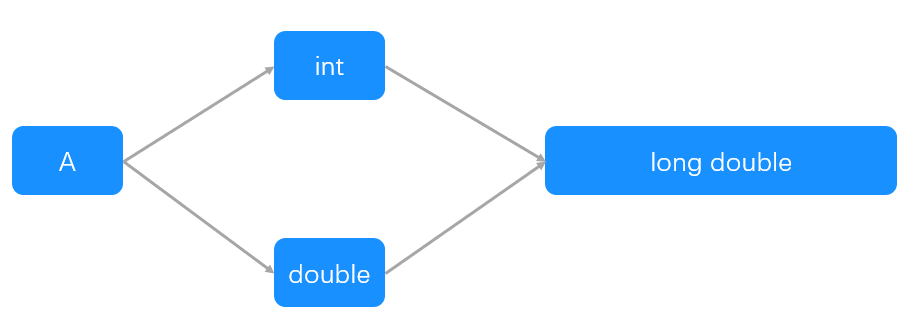
#### 例5
假设有以下类的声明:
```c++
struct A
{
int a;
A(double a) {}
A(int a) {}
};
```
若执行下面代码,则不会出现二义性:
```c++
short b = 3;
A a(b);
```
为什么呢?在对构造函数的调用中,哪个参数类型都无法精确匹配 `short`。但是把 `short` 提升成 `int` 的操作优于把 `short` 转换成 `double` 的操作,因此匹配 `A(int a)` 。(注:类型提升优于其他算术转换,详情参考 *面向过程编程.函数.函数重载* )
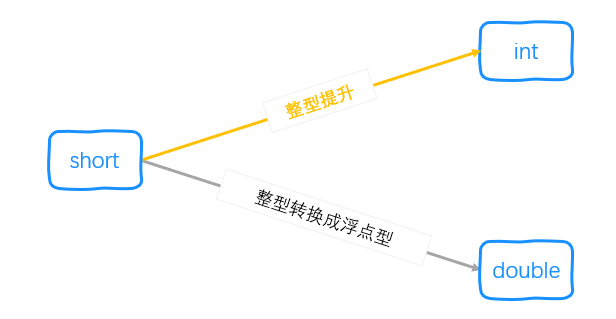
尽管这个例子没有引起二义性,但实际运用中这样写容易出现错误。
### 3.重载函数与转换构造函数
#### 例6
假设有以下类的声明和函数定义:
```c++
struct A
{
int a;
A(int i) {}
};
struct B
{
int b;
B(int i) {}
};
void overload(const A &a){}
void overload(const B &b){}
```
那么,当我们这样调用 `overload` 时,出现了二义性:
```c++
overload(10);//ambiguous call to overloaded function
```
因为这样调用 `overload` 函数时,有下面两种匹配方式,而且差别也不大:
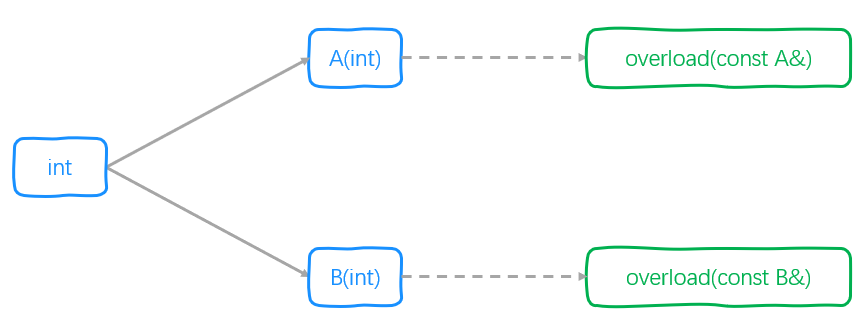
### 4.重载函数与用户定义的转换
当调用重载函数时,如果多个用户定义的类型转换都提供了可行匹配,则我们认为 **这些类型转换优先级相同** 。 在这个过程中,我们不会考虑任何可能出现的标准类型转换的级别。只有当重载函数能通过同名类型转换函数得到匹配时,我们才会考虑其中出现的标准类型转换。
#### 例7
假设有以下类的声明和函数定义:
```c++
struct A
{
int a;
A(int i) {}
};
struct B
{
int b;
B(double i) {}
};
void overload(const A &a){}
void overload(const B &b){}
```
那么,当我们这样调用 `overload` 时,依然会出现二义性:
```c++
overload(10);//ambiguous call to overloaded function
```
尽管在 `B` 中,匹配的函数中间需要将 `int` 转换成 `double` ,但是编译器仍认为 `A(int)` 和 `B(double)` 是差不多的匹配。
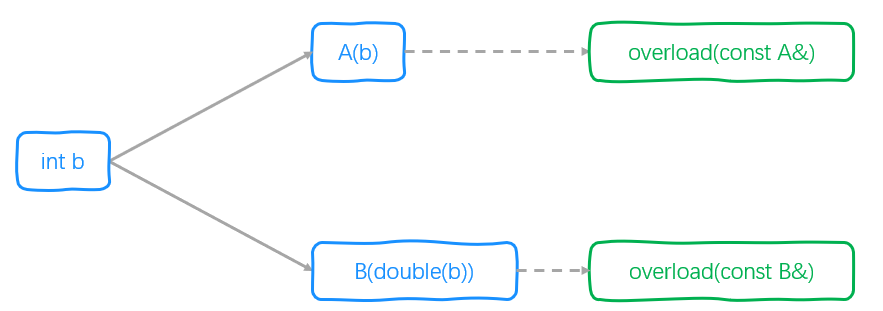
### 5.双向转换与二义性
#### 例8
假设有以下定义和声明:
```c++
class Complex
{
private:
double real_;
double imaginary_;
public:
Complex() : real_(0), imaginary_(0) {}
//包括一个double 到 Complex 的转换
Complex(double real, double imaginary = 0) : real_(real), imaginary_(imaginary) {}
//Complex 到 double 的转换
operator double() const
{
return this->real_;
}
//加法运算友元函数
friend Complex operator+(const Complex& c1,const Complex& c2);
};
Complex operator+(const Complex& c1,const Complex& c2)
{
return Complex(c1.real_ + c2.real_,c1.imaginary_ + c2.imaginary_);
}
```
接下来用 `Complex` 定义两个对象:
```c++
Complex c1(1,2),c2(3,4);
```
下面的运算没有任何问题:
```c++
c1+c2;
```
但是接下来的运算便有了二义性:
```c++
c1+2.5;//2 overloads have similar conversions
```
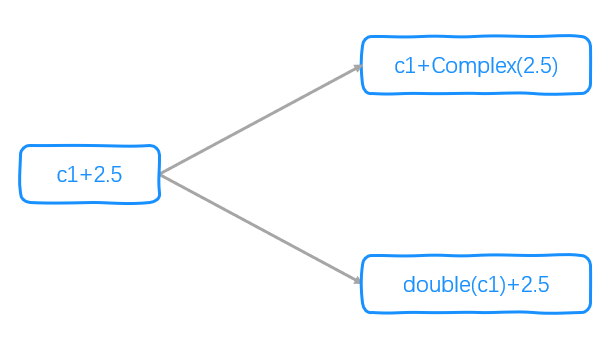
- 阅读说明
- 1.1 概述
- C++基础
- 1.2 变量与常量
- 1.2.1 变量
- 1.2.2 字面值常量
- 字符型常量
- 数值型常量
- 1.2.3 cv限定符
- 1.3 作用域
- 1.3.1 标识符
- 1.3.2 *命名空间
- 1.3.3 作用域
- 1.3.4 可见性
- 1.4 数据类型
- 1.4.1 概述
- 1.4.2 处理类型
- 类型别名
- * auto说明符
- * decltype说明符
- 1.4.3 数组
- 1.4.4 指针
- 1.4.5 引用
- 1.5 表达式
- 1.5.1 概述
- 1.5.2 值的类别
- 1.5.3 *初始化
- 1.5.4 运算符
- 算术运算符
- 逻辑和关系运算符
- 赋值运算符
- 递增递减运算符
- 成员访问运算符
- 位运算符
- 其他运算符
- 1.5.5 *常量表达式
- 1.5.6 类型转换
- 第2章 面向过程编程
- 2.1 流程语句
- 2.1.1 条件语句
- 2.1.2 循环语句
- 2.1.3 跳转语句
- 2.1.4 *异常处理
- 2.2 函数
- 2.2.1 概述
- 2.2.2 函数参数
- 2.2.3 内置函数
- 2.2.4 函数重载
- 2.2.5 * 匿名函数
- 2.3 存储和生命期
- 2.3.1 生命周期与存储区域
- 2.3.2 动态内存
- 2.4 *预处理命令
- 第3章 面向对象编程
- 3.1 概述
- 3.2 类和对象
- 3.3 成员
- 3.3.1 访问限制
- 3.3.2 常成员
- 3.3.3 静态成员
- 3.3.4 成员指针
- 3.3.5 this指针
- 3.4 特殊的成员函数
- 3.4.1 概述
- 3.4.2 构造函数
- 3.4.3 析构函数
- 3.4.4 拷贝语义
- 3.4.5 * 移动语义
- 3.5 友元
- 3.6 运算符重载与类型转换
- 3.6.1 概述
- 3.6.2 重载方法
- 3.6.3 类型转换
- 3.7 继承与多态性
- 3.7.1 概述
- 3.7.2 派生类
- 3.7.3 子类型
- 3.7.4 虚基类
- 3.7.5 虚函数
- 3.7.6 抽象类
- 3.8 模板与泛型
- 3.8.1 概述
- 3.8.2 模板类型
- 3.8.3 *模板参数
- 3.8.4 *模板编译
- 3.8.5 *模板推断
- 3.8.6 *实例化与特例化
- 第4章 C++标准库
- 4.1 概述
- 4.2 输入输出流
- 4.2.1 概述
- 4.2.2 *流的状态
- 4.2.3 *常用流
- 4.2.4 *格式化I/O
- 4.2.5 *低级I/O
- 4.2.6 *随机访问
- 4.3 *C输入输出
- 4.3.1 *字符输入输出
- 4.3.2 *格式化输入输出
- 4.4 * 容器
- 4.4.1 * 概述
- 4.4.2 * 基本操作
- 4.4.3 * 顺序容器
- 4.4.4 * 迭代器
- 4.4.5 * 容器适配器
- 4.5 * 泛型算法
- 4.6 * 内存管理
- 4.6.1 * 自动指针
- 4.7 * 其他设施
